Principles of Macroeconomics
VerifiedAdded on 2022/11/18
|8
|1420
|364
AI Summary
This document covers the principles of macroeconomics including human capital, rule of 70, determinants of economic growth, capital accumulation, technological improvement, and resources. It also includes a production function diagram and references.
Contribute Materials
Your contribution can guide someone’s learning journey. Share your
documents today.
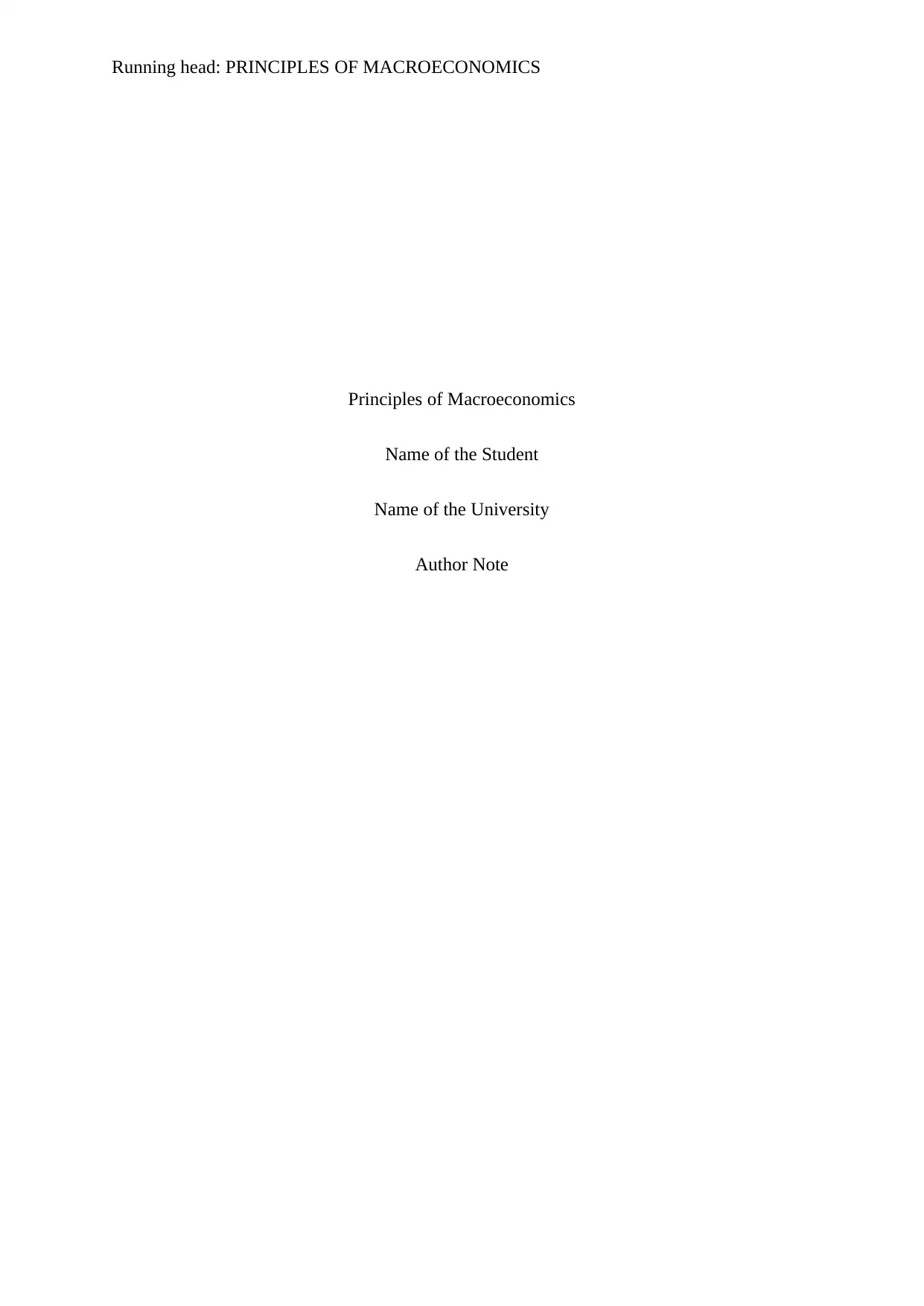
Running head: PRINCIPLES OF MACROECONOMICS
Principles of Macroeconomics
Name of the Student
Name of the University
Author Note
Principles of Macroeconomics
Name of the Student
Name of the University
Author Note
Secure Best Marks with AI Grader
Need help grading? Try our AI Grader for instant feedback on your assignments.
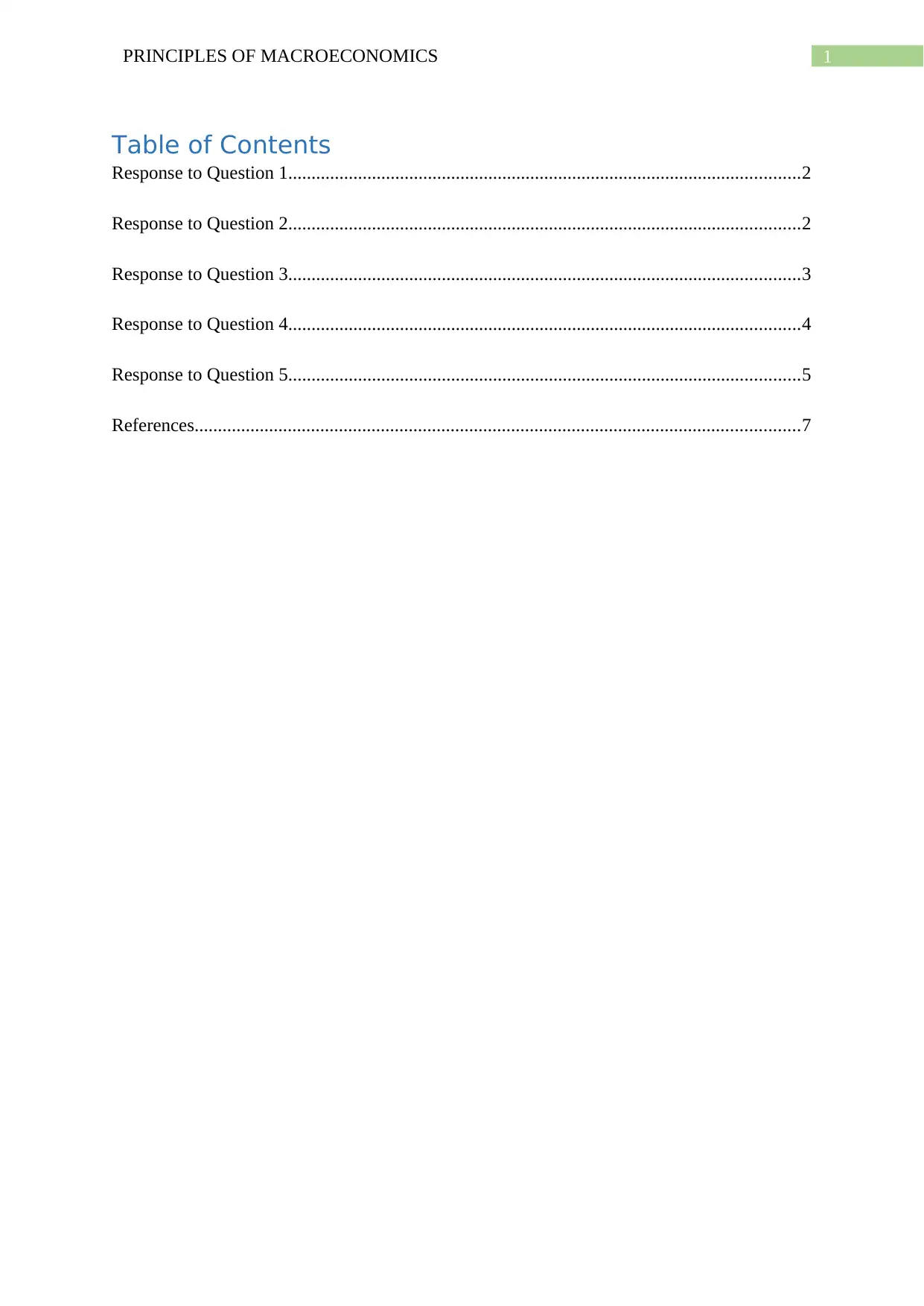
1PRINCIPLES OF MACROECONOMICS
Table of Contents
Response to Question 1..............................................................................................................2
Response to Question 2..............................................................................................................2
Response to Question 3..............................................................................................................3
Response to Question 4..............................................................................................................4
Response to Question 5..............................................................................................................5
References..................................................................................................................................7
Table of Contents
Response to Question 1..............................................................................................................2
Response to Question 2..............................................................................................................2
Response to Question 3..............................................................................................................3
Response to Question 4..............................................................................................................4
Response to Question 5..............................................................................................................5
References..................................................................................................................................7
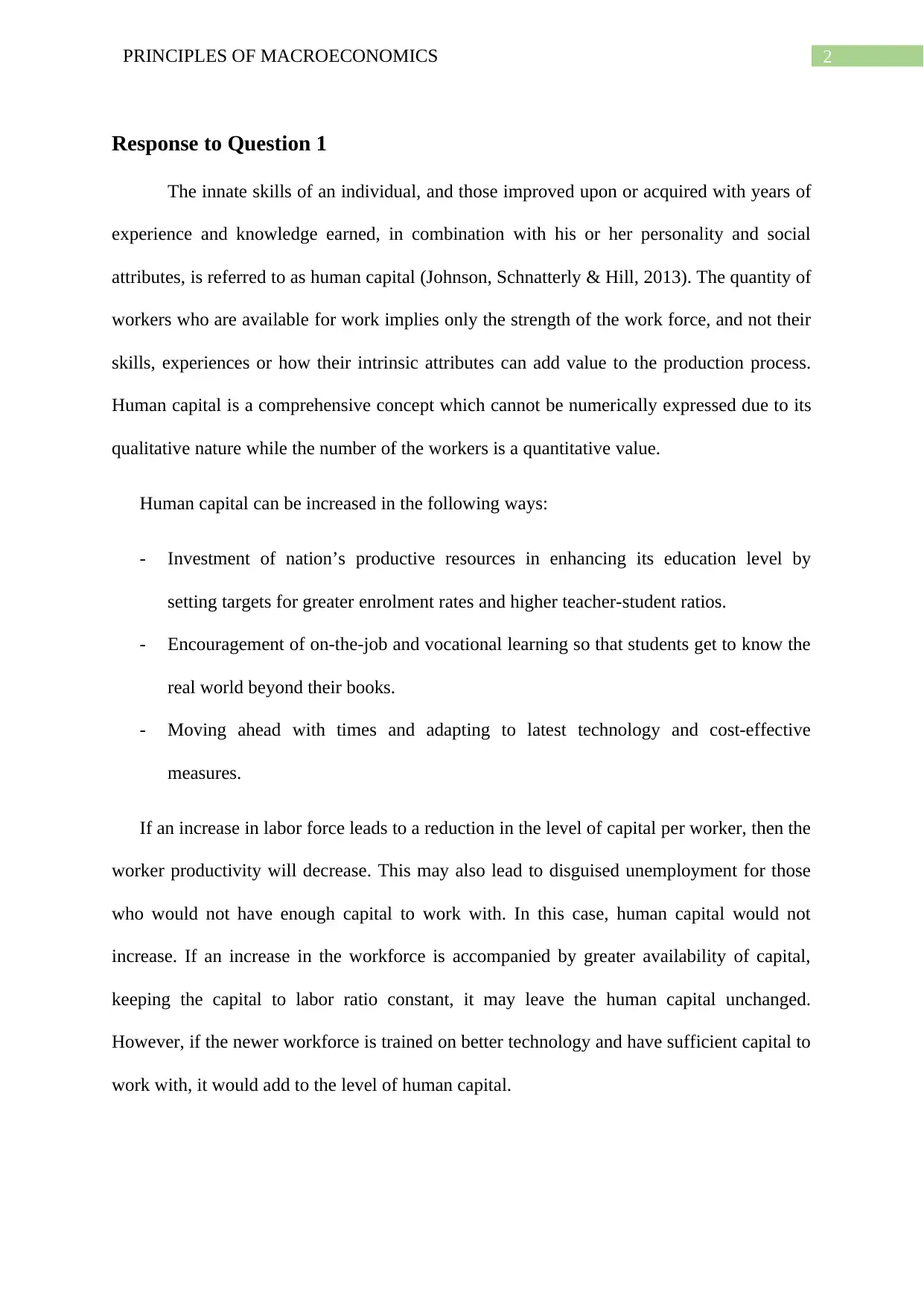
2PRINCIPLES OF MACROECONOMICS
Response to Question 1
The innate skills of an individual, and those improved upon or acquired with years of
experience and knowledge earned, in combination with his or her personality and social
attributes, is referred to as human capital (Johnson, Schnatterly & Hill, 2013). The quantity of
workers who are available for work implies only the strength of the work force, and not their
skills, experiences or how their intrinsic attributes can add value to the production process.
Human capital is a comprehensive concept which cannot be numerically expressed due to its
qualitative nature while the number of the workers is a quantitative value.
Human capital can be increased in the following ways:
- Investment of nation’s productive resources in enhancing its education level by
setting targets for greater enrolment rates and higher teacher-student ratios.
- Encouragement of on-the-job and vocational learning so that students get to know the
real world beyond their books.
- Moving ahead with times and adapting to latest technology and cost-effective
measures.
If an increase in labor force leads to a reduction in the level of capital per worker, then the
worker productivity will decrease. This may also lead to disguised unemployment for those
who would not have enough capital to work with. In this case, human capital would not
increase. If an increase in the workforce is accompanied by greater availability of capital,
keeping the capital to labor ratio constant, it may leave the human capital unchanged.
However, if the newer workforce is trained on better technology and have sufficient capital to
work with, it would add to the level of human capital.
Response to Question 1
The innate skills of an individual, and those improved upon or acquired with years of
experience and knowledge earned, in combination with his or her personality and social
attributes, is referred to as human capital (Johnson, Schnatterly & Hill, 2013). The quantity of
workers who are available for work implies only the strength of the work force, and not their
skills, experiences or how their intrinsic attributes can add value to the production process.
Human capital is a comprehensive concept which cannot be numerically expressed due to its
qualitative nature while the number of the workers is a quantitative value.
Human capital can be increased in the following ways:
- Investment of nation’s productive resources in enhancing its education level by
setting targets for greater enrolment rates and higher teacher-student ratios.
- Encouragement of on-the-job and vocational learning so that students get to know the
real world beyond their books.
- Moving ahead with times and adapting to latest technology and cost-effective
measures.
If an increase in labor force leads to a reduction in the level of capital per worker, then the
worker productivity will decrease. This may also lead to disguised unemployment for those
who would not have enough capital to work with. In this case, human capital would not
increase. If an increase in the workforce is accompanied by greater availability of capital,
keeping the capital to labor ratio constant, it may leave the human capital unchanged.
However, if the newer workforce is trained on better technology and have sufficient capital to
work with, it would add to the level of human capital.
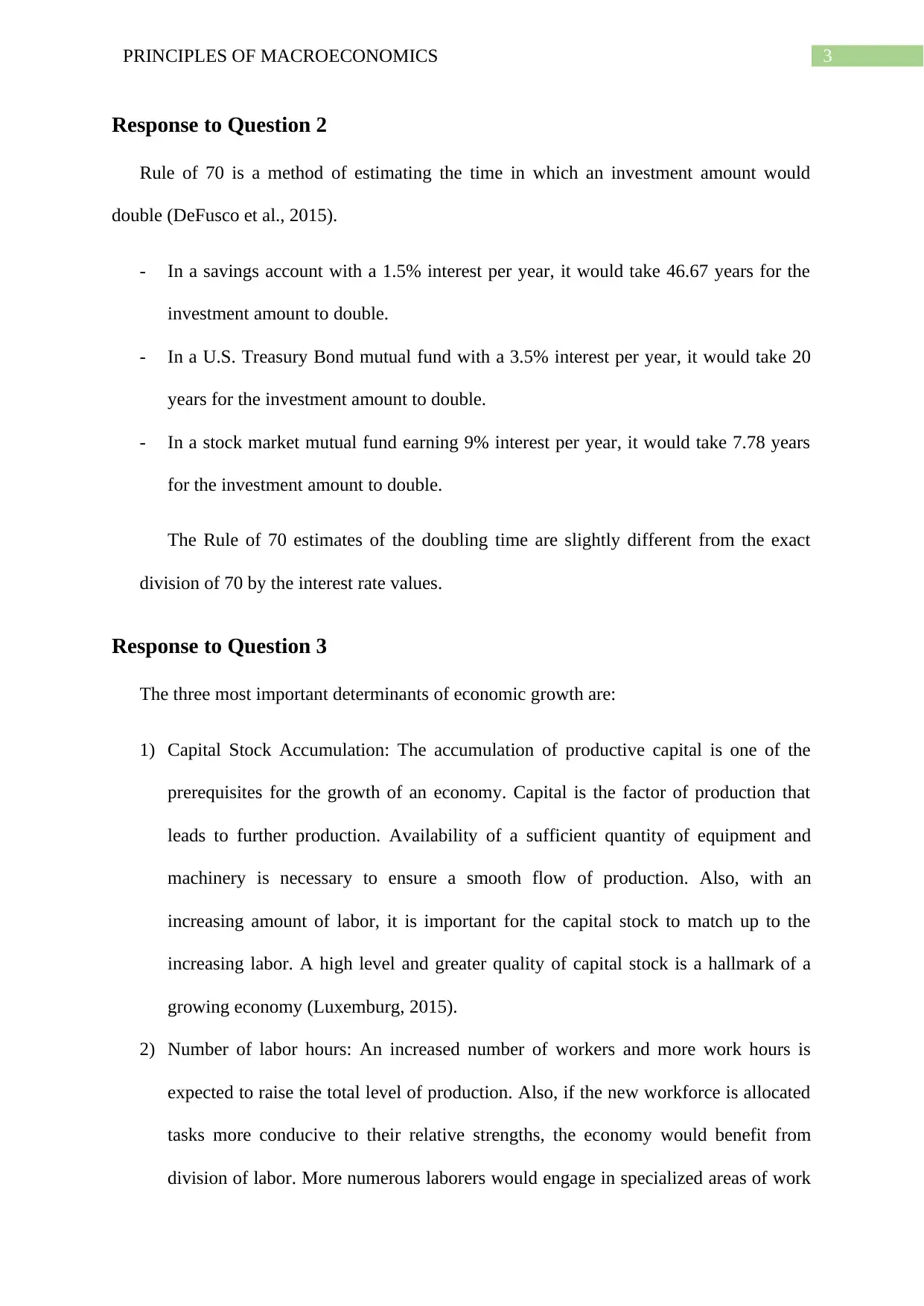
3PRINCIPLES OF MACROECONOMICS
Response to Question 2
Rule of 70 is a method of estimating the time in which an investment amount would
double (DeFusco et al., 2015).
- In a savings account with a 1.5% interest per year, it would take 46.67 years for the
investment amount to double.
- In a U.S. Treasury Bond mutual fund with a 3.5% interest per year, it would take 20
years for the investment amount to double.
- In a stock market mutual fund earning 9% interest per year, it would take 7.78 years
for the investment amount to double.
The Rule of 70 estimates of the doubling time are slightly different from the exact
division of 70 by the interest rate values.
Response to Question 3
The three most important determinants of economic growth are:
1) Capital Stock Accumulation: The accumulation of productive capital is one of the
prerequisites for the growth of an economy. Capital is the factor of production that
leads to further production. Availability of a sufficient quantity of equipment and
machinery is necessary to ensure a smooth flow of production. Also, with an
increasing amount of labor, it is important for the capital stock to match up to the
increasing labor. A high level and greater quality of capital stock is a hallmark of a
growing economy (Luxemburg, 2015).
2) Number of labor hours: An increased number of workers and more work hours is
expected to raise the total level of production. Also, if the new workforce is allocated
tasks more conducive to their relative strengths, the economy would benefit from
division of labor. More numerous laborers would engage in specialized areas of work
Response to Question 2
Rule of 70 is a method of estimating the time in which an investment amount would
double (DeFusco et al., 2015).
- In a savings account with a 1.5% interest per year, it would take 46.67 years for the
investment amount to double.
- In a U.S. Treasury Bond mutual fund with a 3.5% interest per year, it would take 20
years for the investment amount to double.
- In a stock market mutual fund earning 9% interest per year, it would take 7.78 years
for the investment amount to double.
The Rule of 70 estimates of the doubling time are slightly different from the exact
division of 70 by the interest rate values.
Response to Question 3
The three most important determinants of economic growth are:
1) Capital Stock Accumulation: The accumulation of productive capital is one of the
prerequisites for the growth of an economy. Capital is the factor of production that
leads to further production. Availability of a sufficient quantity of equipment and
machinery is necessary to ensure a smooth flow of production. Also, with an
increasing amount of labor, it is important for the capital stock to match up to the
increasing labor. A high level and greater quality of capital stock is a hallmark of a
growing economy (Luxemburg, 2015).
2) Number of labor hours: An increased number of workers and more work hours is
expected to raise the total level of production. Also, if the new workforce is allocated
tasks more conducive to their relative strengths, the economy would benefit from
division of labor. More numerous laborers would engage in specialized areas of work
Secure Best Marks with AI Grader
Need help grading? Try our AI Grader for instant feedback on your assignments.
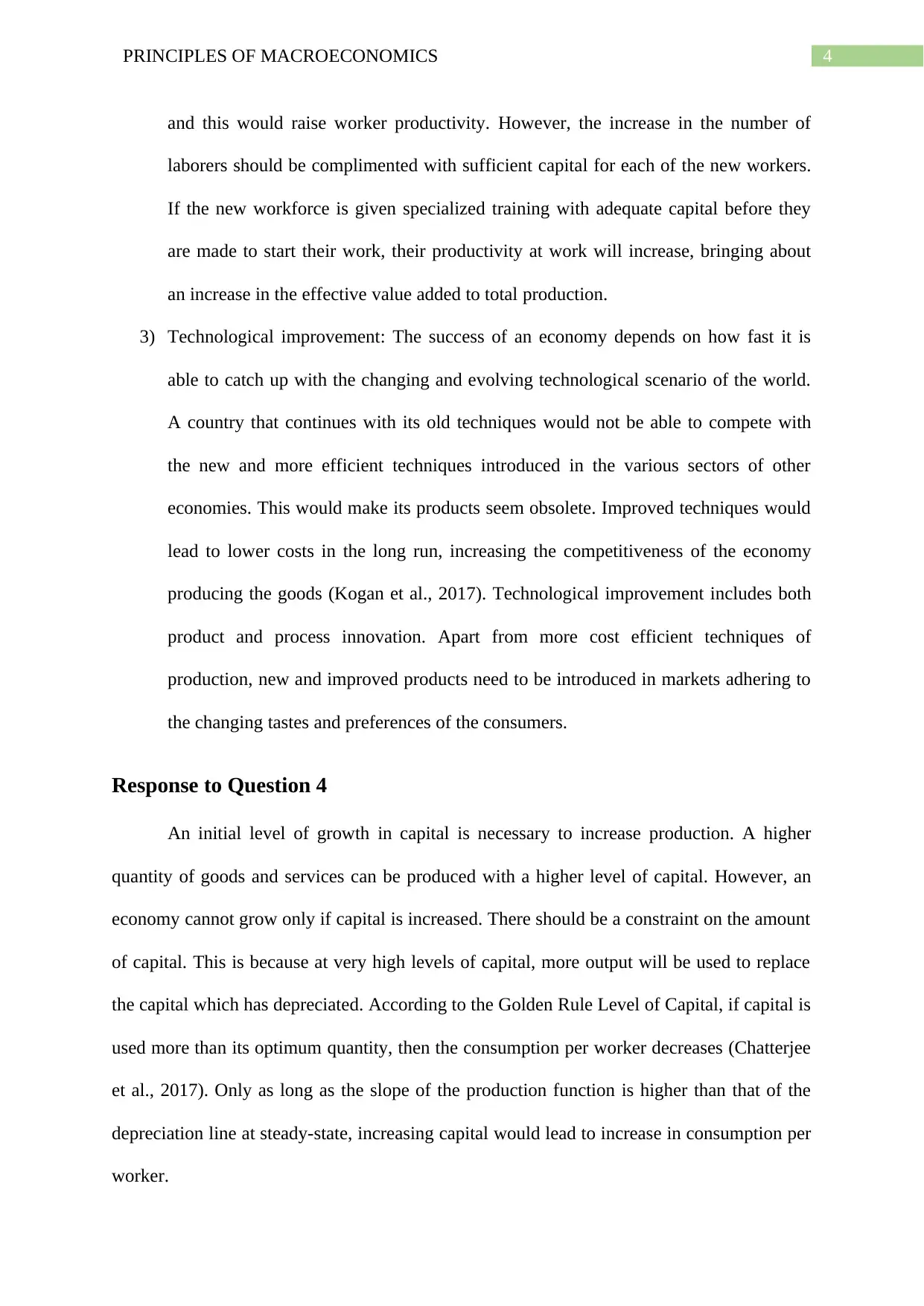
4PRINCIPLES OF MACROECONOMICS
and this would raise worker productivity. However, the increase in the number of
laborers should be complimented with sufficient capital for each of the new workers.
If the new workforce is given specialized training with adequate capital before they
are made to start their work, their productivity at work will increase, bringing about
an increase in the effective value added to total production.
3) Technological improvement: The success of an economy depends on how fast it is
able to catch up with the changing and evolving technological scenario of the world.
A country that continues with its old techniques would not be able to compete with
the new and more efficient techniques introduced in the various sectors of other
economies. This would make its products seem obsolete. Improved techniques would
lead to lower costs in the long run, increasing the competitiveness of the economy
producing the goods (Kogan et al., 2017). Technological improvement includes both
product and process innovation. Apart from more cost efficient techniques of
production, new and improved products need to be introduced in markets adhering to
the changing tastes and preferences of the consumers.
Response to Question 4
An initial level of growth in capital is necessary to increase production. A higher
quantity of goods and services can be produced with a higher level of capital. However, an
economy cannot grow only if capital is increased. There should be a constraint on the amount
of capital. This is because at very high levels of capital, more output will be used to replace
the capital which has depreciated. According to the Golden Rule Level of Capital, if capital is
used more than its optimum quantity, then the consumption per worker decreases (Chatterjee
et al., 2017). Only as long as the slope of the production function is higher than that of the
depreciation line at steady-state, increasing capital would lead to increase in consumption per
worker.
and this would raise worker productivity. However, the increase in the number of
laborers should be complimented with sufficient capital for each of the new workers.
If the new workforce is given specialized training with adequate capital before they
are made to start their work, their productivity at work will increase, bringing about
an increase in the effective value added to total production.
3) Technological improvement: The success of an economy depends on how fast it is
able to catch up with the changing and evolving technological scenario of the world.
A country that continues with its old techniques would not be able to compete with
the new and more efficient techniques introduced in the various sectors of other
economies. This would make its products seem obsolete. Improved techniques would
lead to lower costs in the long run, increasing the competitiveness of the economy
producing the goods (Kogan et al., 2017). Technological improvement includes both
product and process innovation. Apart from more cost efficient techniques of
production, new and improved products need to be introduced in markets adhering to
the changing tastes and preferences of the consumers.
Response to Question 4
An initial level of growth in capital is necessary to increase production. A higher
quantity of goods and services can be produced with a higher level of capital. However, an
economy cannot grow only if capital is increased. There should be a constraint on the amount
of capital. This is because at very high levels of capital, more output will be used to replace
the capital which has depreciated. According to the Golden Rule Level of Capital, if capital is
used more than its optimum quantity, then the consumption per worker decreases (Chatterjee
et al., 2017). Only as long as the slope of the production function is higher than that of the
depreciation line at steady-state, increasing capital would lead to increase in consumption per
worker.
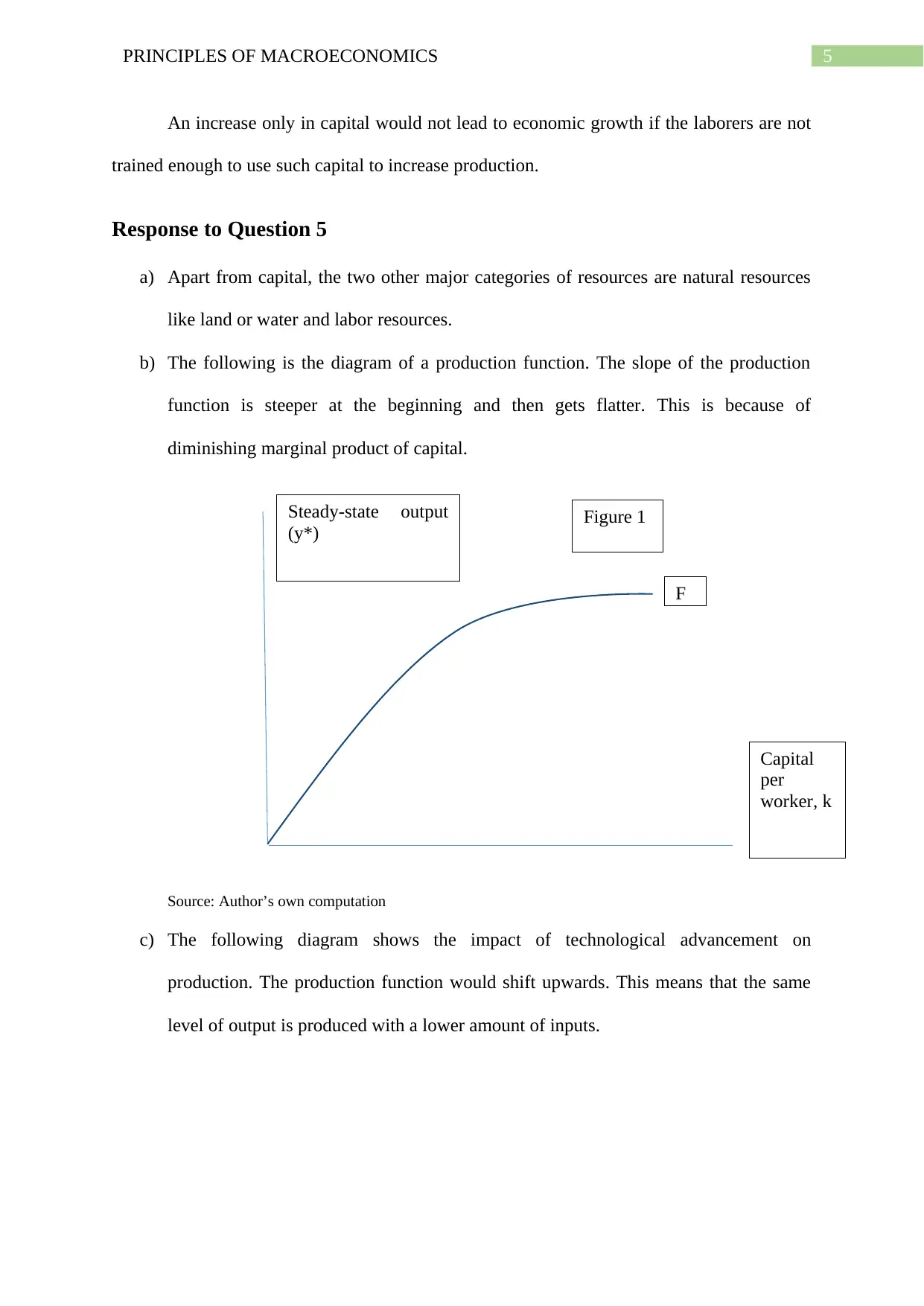
5PRINCIPLES OF MACROECONOMICS
Capital
per
worker, k
Steady-state output
(y*) Figure 1
F
An increase only in capital would not lead to economic growth if the laborers are not
trained enough to use such capital to increase production.
Response to Question 5
a) Apart from capital, the two other major categories of resources are natural resources
like land or water and labor resources.
b) The following is the diagram of a production function. The slope of the production
function is steeper at the beginning and then gets flatter. This is because of
diminishing marginal product of capital.
Source: Author’s own computation
c) The following diagram shows the impact of technological advancement on
production. The production function would shift upwards. This means that the same
level of output is produced with a lower amount of inputs.
Capital
per
worker, k
Steady-state output
(y*) Figure 1
F
An increase only in capital would not lead to economic growth if the laborers are not
trained enough to use such capital to increase production.
Response to Question 5
a) Apart from capital, the two other major categories of resources are natural resources
like land or water and labor resources.
b) The following is the diagram of a production function. The slope of the production
function is steeper at the beginning and then gets flatter. This is because of
diminishing marginal product of capital.
Source: Author’s own computation
c) The following diagram shows the impact of technological advancement on
production. The production function would shift upwards. This means that the same
level of output is produced with a lower amount of inputs.
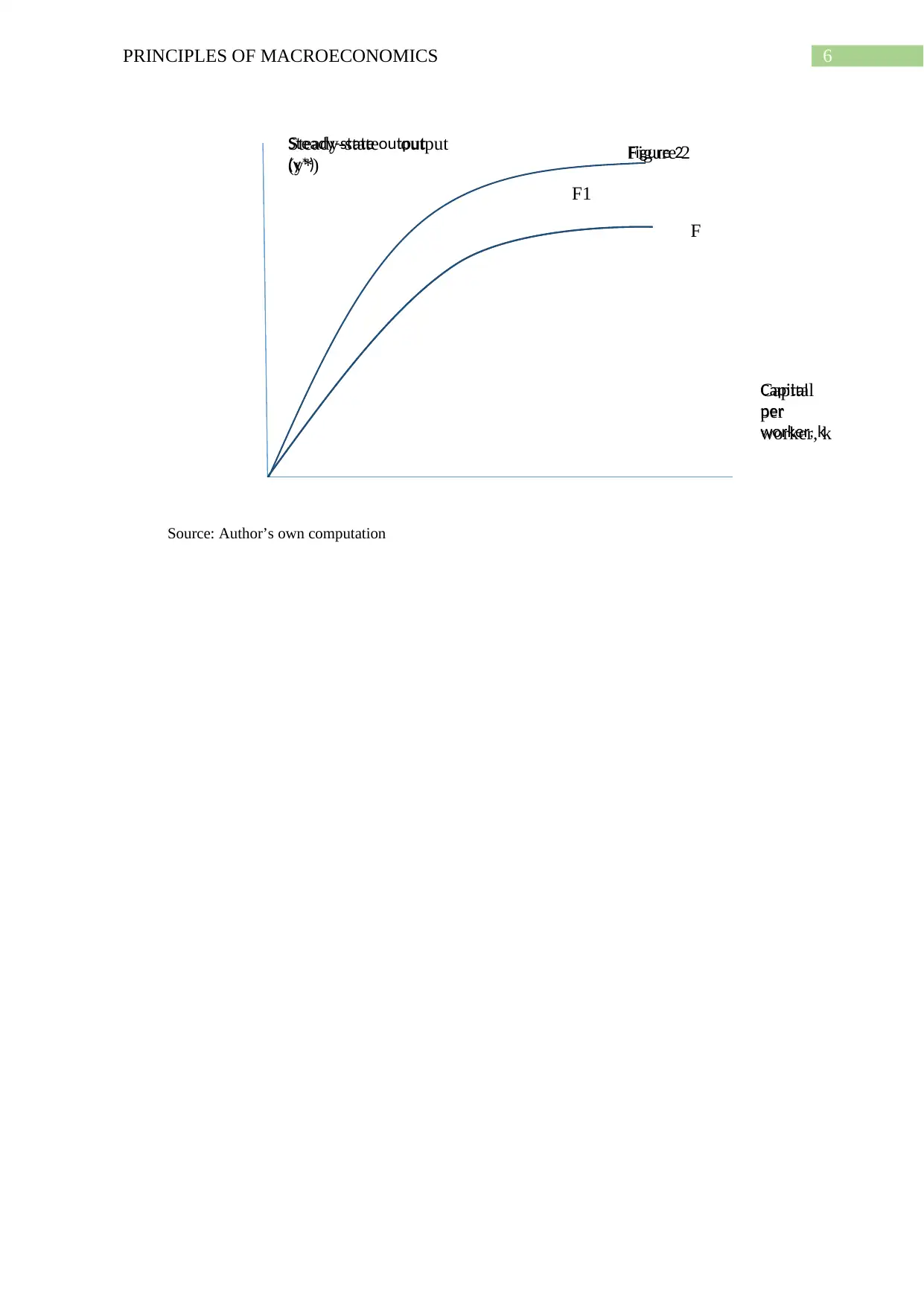
6PRINCIPLES OF MACROECONOMICS
Capital
per
worker, k
Steady-state output
(y*) Figure 2
Capital
per
worker, k
Steady-state output
(y*) Figure 2
F
F1
Source: Author’s own computation
Capital
per
worker, k
Steady-state output
(y*) Figure 2
Capital
per
worker, k
Steady-state output
(y*) Figure 2
F
F1
Source: Author’s own computation
Paraphrase This Document
Need a fresh take? Get an instant paraphrase of this document with our AI Paraphraser
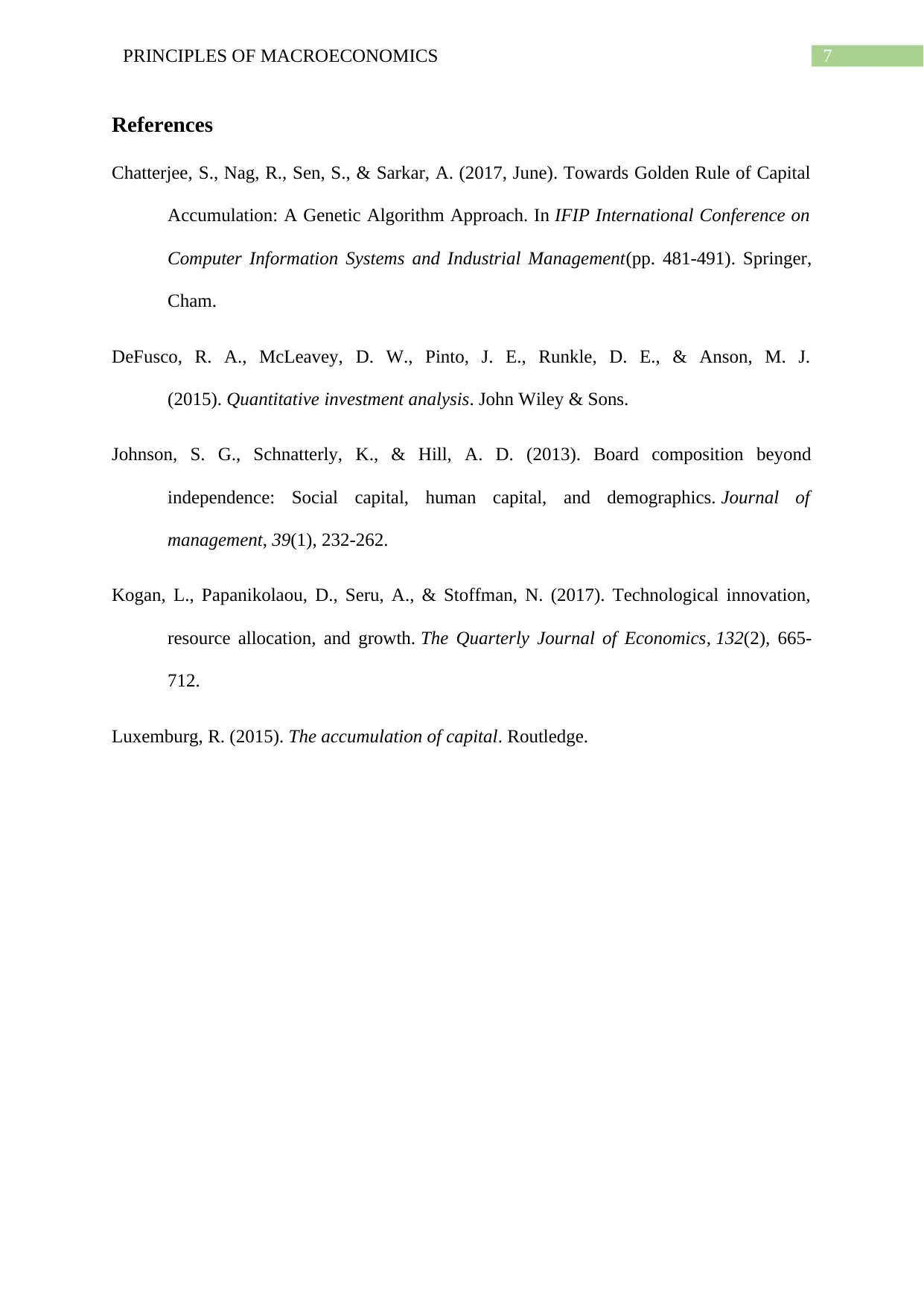
7PRINCIPLES OF MACROECONOMICS
References
Chatterjee, S., Nag, R., Sen, S., & Sarkar, A. (2017, June). Towards Golden Rule of Capital
Accumulation: A Genetic Algorithm Approach. In IFIP International Conference on
Computer Information Systems and Industrial Management(pp. 481-491). Springer,
Cham.
DeFusco, R. A., McLeavey, D. W., Pinto, J. E., Runkle, D. E., & Anson, M. J.
(2015). Quantitative investment analysis. John Wiley & Sons.
Johnson, S. G., Schnatterly, K., & Hill, A. D. (2013). Board composition beyond
independence: Social capital, human capital, and demographics. Journal of
management, 39(1), 232-262.
Kogan, L., Papanikolaou, D., Seru, A., & Stoffman, N. (2017). Technological innovation,
resource allocation, and growth. The Quarterly Journal of Economics, 132(2), 665-
712.
Luxemburg, R. (2015). The accumulation of capital. Routledge.
References
Chatterjee, S., Nag, R., Sen, S., & Sarkar, A. (2017, June). Towards Golden Rule of Capital
Accumulation: A Genetic Algorithm Approach. In IFIP International Conference on
Computer Information Systems and Industrial Management(pp. 481-491). Springer,
Cham.
DeFusco, R. A., McLeavey, D. W., Pinto, J. E., Runkle, D. E., & Anson, M. J.
(2015). Quantitative investment analysis. John Wiley & Sons.
Johnson, S. G., Schnatterly, K., & Hill, A. D. (2013). Board composition beyond
independence: Social capital, human capital, and demographics. Journal of
management, 39(1), 232-262.
Kogan, L., Papanikolaou, D., Seru, A., & Stoffman, N. (2017). Technological innovation,
resource allocation, and growth. The Quarterly Journal of Economics, 132(2), 665-
712.
Luxemburg, R. (2015). The accumulation of capital. Routledge.
1 out of 8
Related Documents
Your All-in-One AI-Powered Toolkit for Academic Success.
+13062052269
info@desklib.com
Available 24*7 on WhatsApp / Email
![[object Object]](/_next/static/media/star-bottom.7253800d.svg)
Unlock your academic potential
© 2024 | Zucol Services PVT LTD | All rights reserved.




